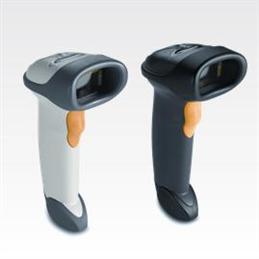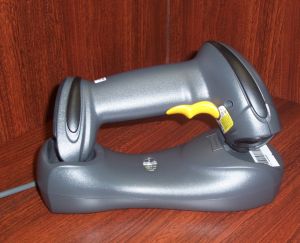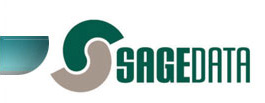Introduction
This page is written for the benefit of those who are considering purchasing a barcode reader, or considering including barcode technology within a new application.
Definitions
A barcode reader is a device capable of "viewing" a barcode, interpreting its content and passing that in electronic form to some kind of application.
Differences Between Readers
Standalone or Integrated Barcode Readers
barcode readers can be designed for use with an existing desktop workstation or laptop, or integrated within a handheld computer. Readers designed for use with workstations can be either directly plugged in, by cable, or use a wireless (cordless) connection.
Reading technology
The dominant technology for reading barcodes until a few years ago was laser. That is gradually being replaced by imagers. Laser readers work by illuminating the barcode with a spot of light (usually a red dot) which moves across the stripes of the barcode. The reflected light is read and converted to a stream of ones and zeros which can be translated into the data contained by the barcode.
Imagers work by taking a picture of the barcode and then analysing the image to determine the data that is encoded. Imagers themselves come in two types. The early types took a picture of the whole field of view for analysis. More recently "linear imagers" project a line which the user positions across the barcode. These are less expensive than full imagers and can provide a more rapid response.
How to Choose the Best Reader for Your Application.
The following sections list some of the questions to be asked, and identify the best barcode reader indicated by the various answers.
Does the System Used 2-D Barcodes?
2-D barcodes are generally best avoided. In most cases they do not add any real functionality to the system and they require special readers which are more expensive than those required for the standard 1-D barcodes. So use 1-D barcodes and 1-D readers where possible.
Do You Need to Read Barcodes Displayed on a Computer Monitor?
An image you can read barcodes displayed on a monitor, but the laser scanner cannot.
Do I Need to Read Barcodes on Large and Bulky Items?
if you are using a desktop workstation or laptop computer, we generally recommend a cordless barcode reader. These are slightly more expensive than corded readers but offer significant advantages in convenience, especially when reading barcodes on large bulky items such as a shipping pallet.
Do You Need to Read Barcodes Long-Range?
This is a common question and it has a non-intuitive answer. Although some barcode readers are capable of reading barcoded labels at a range of 30 feet or more, this is in practice not usually a "real world" requirement. In almost every application barcodes are read on items which are either just handled or just about be handled. The standard barcode reader can usually read barcodes at a range of 1 to 3 feet, so this is more than adequate for the majority of real-world applications. Although we have had many discussions about long-range readers over the last 20 years, it is extremely rare for us to supply them. As long client put it, at the end of a discussion on the subject "so although I want one, I don't really need one?"
What Budget Do You Have Available?
If budget constraints are really tight, the least expensive way to read barcode is with a corded reader plugged into a lap top computer or desktop workstation. Think in terms of $300 for a good quality reader. If possible we would recommend a cordless Reader, think in terms of around $600 for budgetary planning. Barcode readers for handheld computers will vary in price according to capability, but generally fall in the same bracket of $300-$600 on top of the standard price for the handheld computer.
Can I Use the Camera to Read the Barcode?
Some low-end handheld computers do not have a dedicated barcode scanner, but read barcodes through the camera. Disadvantages of this approach include the delay in decoding the signal, which may run to two or three seconds, and less capability in reading barcodes which may be damaged or not fully compliant with specifications (which is a common situation).
What Symbologies Do I Need to Read?
Barcodes can be encoded with many different symbologies. Modern barcode readers have the ability to read many different symbologies or be set up for one specific symbology, and ignore all others. Depending on the application this can be a useful feature. Also by limiting the number of symbologies which a reader can interpret, response time can sometimes be improved.
Do I Need to Process the Information in the Barcode?
When setting up a barcode reader it is sometimes possible to define prefixes or suffixes. It is possible to design a system such that after a barcode has been read a carriage return or tab character is automatically appended to the data stream . This is convenient when entering data into an existing application.
Will the Reader Be Operating in Wedge Mode?
Readers that are used with the desktop workstation can be set up to inject the data read from the barcode as if it had come directly from the keyboard. The application is unable to determine whether that information came from someone reading a barcode or whether there was a really fast typist using the keyboard. This provides extreme flexibility in that a barcode reader can be used with any application. The contents of the barcode can be injected into a Word document, a spreadsheet or any other similar application, exactly as if it had been entered through the keyboard.
When readers are not used in wedge mode, the application is often looking for some specific input from the barcode reader, and in this case a specific model and configuration is usually specified by the application.
Will the Reader Be Subject to Rough Treatment?
Although laser scanners are extremely tough, and considerably tougher than they were even five or 10 years ago, they still use a moving part, and are inherently less reliable than imagers, which are in effect using a small digital camera to read the barcode. because the digital camera is entirely solid-state it is inherently more robust.
Conclusion.
By far the majority of applications which we provide are satisfied by one of two configurations of barcode reader. For desktop workstations and laptops, we recommend a cordless scanner which can be configured with appropriate symbologies and prefix and suffix. For mobile applications using a handheld computer, we usually specify a linear imager, which gives the best combination of low-cost and effective scanning capability.
In this note our objective was to give you, the reader, an introduction to the topic. Please feel free to browse the rest of this site. The "Learning Centre" section is intended to provide generic information on Barcode Technology and associated disciplines. Other sections of this site provide information on the products and solutions offered by SageData, as well as some information on specific systems that we have designed and implemented.
If you would like further and more detailed information on your specific application, please feel free to call or email with your questions. One of our Inventory Management Experts will be pleased to help you. Enjoy.
For more information...
SageData is based in Ottawa, Ontario, Canada.
We design systems around RFID, Barcodes and Handheld computers.
For further information, contact Doreen Wallace or Keith Jackson.
To reach us by email, click here.
To reach us by phone from Ottawa, dial 613 225 4404
To reach us by phone from outside Ottawa, dial 1-888-838-1067
(c) SageData . Ottawa . Ontario . Canada
QAP









